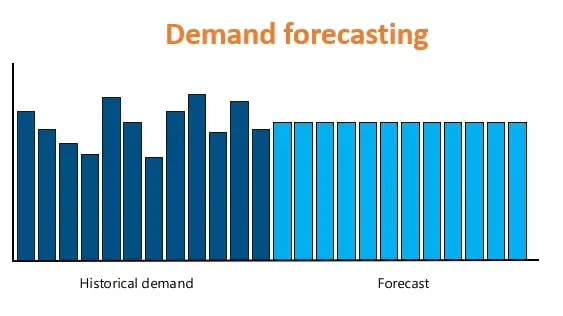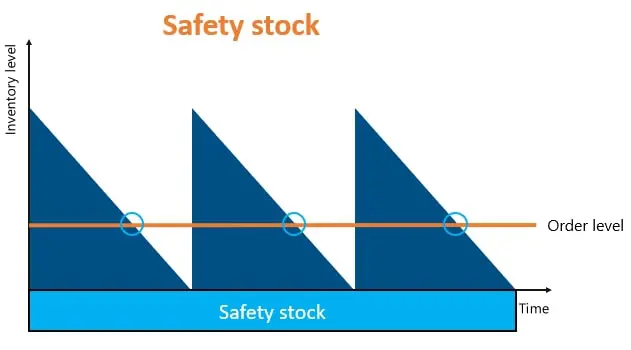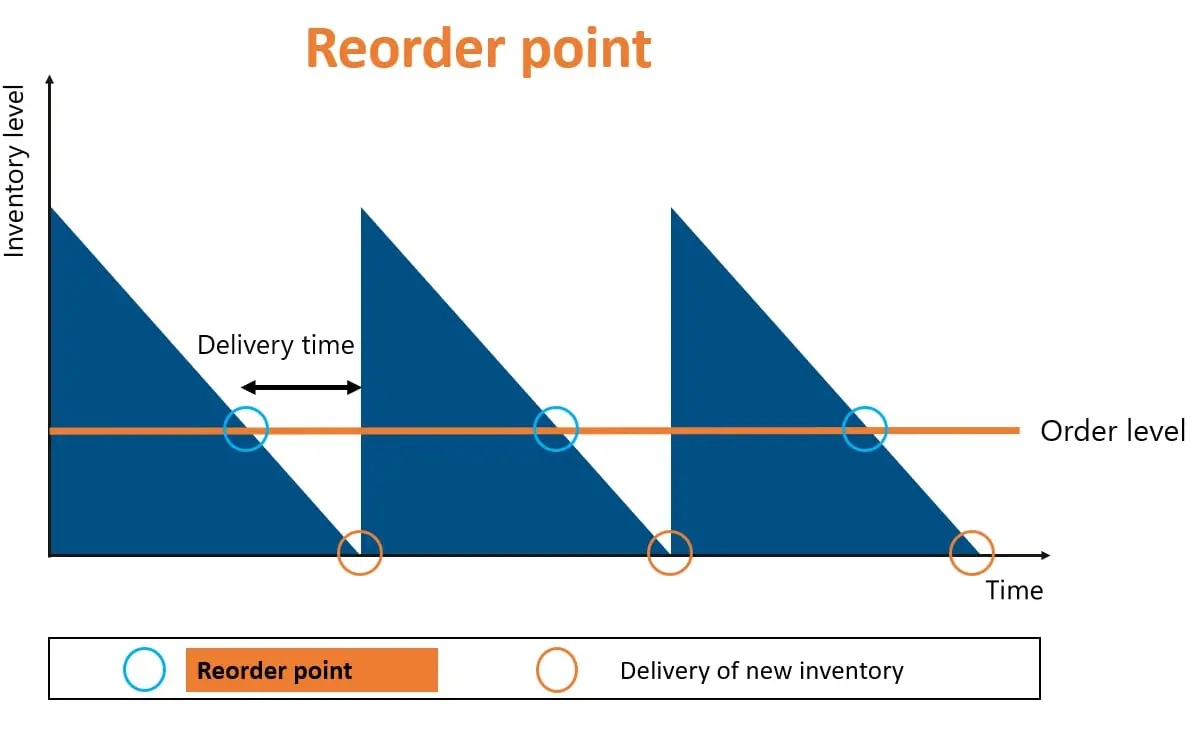Table of contents
Table of contents- Inventory Management: 7 Things You Need To Know
- Definition of Inventory Management
- Difference between Inventory Management & Inventory Control
- The importance of data in inventory management
- Inventory management system
- Inventory management techniques
- 6. Inventory management types
- 7. Inventory management terms
- Inventory management with Slimstock
Definition of Inventory Management
In logistics, inventory management is often referred to as the management of the incoming and outgoing goods at a company (by means of planning tools) to make sure materials are available for sale.
It is all about aligning people, processes, and technology to ensure you have the right products, at the right place at the right time.
This might sound easy but can be a rather complex process as there are many inventory management techniques and inventory management types which will be discussed within this blog.
Difference between Inventory Management & Inventory Control
Often the terms inventory management & inventory control are mixed up. Not everyone seems to be aware of the difference between these two terms.
Inventory management is the process of tracking inventory throughout the supply chain, from sourcing to order fulfilment, while inventory control is the process of managing stock once it arrives at the warehouse, store or other storage location.
Stock counts, quality control, item locations and storage in a safe manner are therefore all part of inventory control. Often companies make use of a warehouse management system to control their inventory.
Inventory management on the other hand is focused on determining the required inventory levels at the different locations to meet customer demand while keeping the costs as low as possible. The required quantities are based on the forecasted demand, taking into account minimum order quantities (MOQ), supplier lead-times, etc. Many companies make use of a forecasting and inventory management system to efficiently manage their inventory.
The importance of data in inventory management
Real-time insights in your inventory situation is vital to stay ahead of competition. How much inventory do you have, at which location, what are the lead times, how reliable is your supplier?
Keeping clear insight into all items and locations in a spreadsheet is only doable if you have a limited assortment. However many companies carry a broad assortment to satisfy their customers making proper inventory management much more complex. Often leading to significant problems when not being able to keep on top of the demand and supply of each item.
Forrester reported that around 65% of the data within a company isn’t used. Many companies make inventory decisions based on gut feeling and many years of experience. Generally this doesn’t give you the best results, did you for example know that toilet paper has a seasonal pattern? The responsible inventory planner who had been in the company for many years wasn’t aware of it either. Data is very valuable (in inventory management) so make sure it is used to gain critical insight!
Inventory management system
Inventory management systems manage the inventory of a company throughout the entire supply chain. The system helps companies to efficiently and effectively manage their inventory by tracking the inventory levels, purchase order and expected deliveries. The system will calculate the required safety stock levels and reorder points. Taking into account lead times, minimum order quantities, etc. Furthermore a proper inventory management system is able to calculate the demand forecast for each individual item/location combination based on historical sales, can calculate the EOQ and fills up orders to full truck loads/containers automatically. On strategic level ABC-XYZ analyses can be performed and service levels can be set for each item to guarantee you have the right amount of inventory at the right location. An inventory management software integrates with a company’s ERP system and can run on premise or in the cloud.
Why do companies implement an inventory management system?
An inventory management system helps to prevent overstock and understock situations as the system bases its outcome in statistics instead of gut feeling. Moreover a system is able to review and recalculated the complete portfolio of items daily, which is undoable for planners. A system reduces the amount of time required to manage inventory, moreover it make sure the right amount of inventory is available at the right place and right time to meet your customer’s demand. Significantly reducing the amount of capital stuck in inventory which is actually not needed, or the possibility of running out of stock because you hadn’t detected the upward trend of an item/seasonality. With our software Slim4 we are able to achieve:
- 10% – 30% reduction in inventory
- 2% – 7% increase in sales based on an increased availability
- Up to 50% reduction in stock outs
Inventory management techniques
Not making use of inventory management techniques means a company is not managing its inventory optimally. Capital will be stuck in non-required inventory or lost sales is experienced because not enough inventory is available for particular items. The following techniques will help companies to improve its inventory management:
Demand forecasting
Based on the historic demand of an item a future forecast can be calculated. It is vital that seasonality is taking into account and trends are constantly monitored to ensure forecasts are adjusted accordingly.
A good decision needs a reliable forecast.
Many companies these days have occasional or regular promotions, when not properly isolating the promotional demand the demand history of an item can become ‘contaminated’. Meaning that historic sales will most probably show a spike in demand because of the promotion, however this spike won’t reoccur next month or next year when the promotion doesn’t take place. Cleaning this historical promotional data is therefore of vital importance with inventory management to keep your data clean.
ABC Analysis
Once the forecast has been established for all items the optimal safety stock can be calculated. Minimum order quantities and desired service levels should influence the safety stock. It is possible to determine the service level for an item based on an ABC analysis.
ABC analysis help companies with their inventory management by classifying items into three different categories: A, B an C. If an item has a high contribution to the company’s performance it will be classified as an A-article. A higher service level for these times is recommended. A more advanced analysis can be performed with an ABC-XYZ analysis. You can find more information about these type of analysis here.
Safety stock
To put it simple, safety stock is the amount of extra stock which is kept to reduce the risk of out of stock situations. Safety stock is required to coop with the fluctuations in demand. When an item has a stable sales pattern less safety stock is required, in contrary to items with a very high deviation in demand. With inventory management it is important to calculate the right safety stock level to mitigate risk of stockouts but also the risk of overstock situations.
Reorder point
The reorder point is a point at which new inventory should be ordered to be able to meet future demand. Calculating the reorder point enables you to determine when it is the best time to purchase new items. If an order is placed too early there is a high probability of ending up with excess inventory leading to high storage costs. Ordering too late however can result in out of stocks, impacting customer satisfaction.
Economic Order Quantity (EOQ)
In inventory management, Economic Order Quantity (EOQ) enables you to find the optimum orderquantity which guarantees the lowest total costs looking at both holding costs and ordering costs. Of course a company’s holding costs increase when more items need to be temporary stored till they are sold. On the contrary, ordering costs are reduced when items are purchased in bigger quantities and therefore less often. Watch our short movie in which we explain the EOQ.
First in, First out (FIFO)
In inventory management the term FIFO stands for First-in, First-out. Products which are first purchased are also first sold. This inventory methodology is for example used a lot in retail environments, since many products have an expiry date. Consuming the items which have the shortest shelf life first is therefore preferable to reduce waste. Furthermore this methodology is also often used when items have a warranty period, like for example electronic components, motors, etc.
Just in time (JIT)
Just-in-time (JIT) inventory management, is a workflow methodology used in manufacturing environments with the aim of delivering product just before the start of a production process. Leading to less stock on the production floor before and in between production steps.
6. Inventory management types
There are different inventory management types, the most common types have been summed up underneath:
- Raw materials
Raw materials are parts which are processed during the manufacturing process to become components, semi- finished or finished products
- Work-in progress
Are all the items which are waiting for the final or further production steps to take place. An item which is only a part of a final item but not a raw material is seen as work-in-progress
- Finished goods
Is a part which can be ordered by a customer, this is the product which is kept in the warehouse before its being sold
- Transit inventory
Also known as pipeline inventory, transit inventory is inventory which is transferred between two locations and therefore not readily available
7. Inventory management terms
There are many terms related to inventory management, a sumup of some of the terms can be found underneath:
- Cost of goods sold (COGS)
Is the combination of costs which are directly related to the production of the goods which are sold. This is important as a company’s gross profit is calculated by subtracting the COGS from the companies revenue.
- Deadstock
Available items which where intended to be sold to customers but haven’t, therefore they were written off. In most cases the items are expired or outdated, which for example occurs when a new model is introduced to the market.
- Holding cost
The costs of holding inventory in the warehouse, which includes labor, space, depreciation and insurance costs.
- Order cost
Order costs are the costs involved in creating and processing a purchase order to a supplier. These costs include the labor costs of the buyer but could also include the labor costs required to perform inspections once items arrive at the warehouse
- Lead time
The time between placing the purchase order and receiving the physical goods from the supplier in the warehouse.
- Purchase order
This is a document created by the buyer which is distributed to the supplier and indicates a demand for specific products or goods.
- Stock keeping unit (SKU)
In the area of inventory management a SKU is a unique number given to a product to enable easy identification and internal tracking of the inventory. Each company has its own way of determining the SKU number. A SKU number could for example consist of the color code, product type, size and manufacturing code.
- Order cost Minimum order quantity (MOQ)
Is the minimum quantity a supplier agrees to supply when receiving demand for a certain product. It could for example be that a supplier only wants to supply in full pallets or card boxes.
Inventory management with Slimstock
Slimstock is the expert in forecasting and inventory management. With Slim4, we help almost a thousand organisations worldwide to manage their inventory. We support them to make sure the right amount of stock is available at the right place at the right time. Do you want to find the right balance between working capital, operational costs and an optimal service level towards your customers? Feel free to contact us or have a look at some of our business cases.
Interested to read more? Have a look at our free whitepapers.









